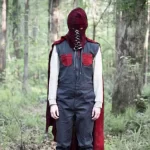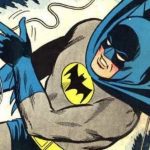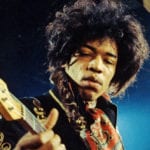 Weird Stuff
Weird Stuff  Weird Stuff
Weird Stuff  Humans
Humans The Ten Most Lethal Gunslingers of the Old West
 Misconceptions
Misconceptions 10 Phony Myths and Urban Legends That Just Won’t Die
 History
History 10 Amazing Roman Epitaphs
 Weird Stuff
Weird Stuff 10 Niche Subcultures That Are More Popular Than You Might Think
 Mysteries
Mysteries 10 Tragic Disappearances and Deaths in Joshua Tree National Park
 History
History 10 Ways Childhood Really Sucked in the Old West
 Music
Music 10 Name Origins of Famous Bands from the 1990s
 Religion
Religion 10 Biggest Turnarounds by the Catholic Church
 Weird Stuff
Weird Stuff 10 Unbelievable Times Laws Had Unintended Consequences
 Weird Stuff
Weird Stuff 10 Cool and Creepy Facts about Collecting Tears
 Humans
Humans The Ten Most Lethal Gunslingers of the Old West
 Misconceptions
Misconceptions 10 Phony Myths and Urban Legends That Just Won’t Die
Who's Behind Listverse?

Jamie Frater
Head Editor
Jamie founded Listverse due to an insatiable desire to share fascinating, obscure, and bizarre facts. He has been a guest speaker on numerous national radio and television stations and is a five time published author.
More About Us History
History 10 Amazing Roman Epitaphs
 Weird Stuff
Weird Stuff 10 Niche Subcultures That Are More Popular Than You Might Think
 Mysteries
Mysteries 10 Tragic Disappearances and Deaths in Joshua Tree National Park
 History
History 10 Ways Childhood Really Sucked in the Old West
 Music
Music 10 Name Origins of Famous Bands from the 1990s
 Religion
Religion 10 Biggest Turnarounds by the Catholic Church
 Weird Stuff
Weird Stuff 10 Unbelievable Times Laws Had Unintended Consequences
10 Iconic Superhero Hallmarks That Didn’t Originate in Comics
Superheroes are constantly being revamped in both comic books and on screen, but there are usually a few defining hallmarks that remain consistent. For instance, Spider-Man is usually depicted as a teenager, often called Peter Parker, who is bitten by a radioactive spider. Even when his classic red and blue costume is changed—Miles Morales gets red and black, while Spider-Gwen’s is white, pink, black, and blue—the distinctive web pattern remains.
These iconic details are usually established on the pages of comic books, but occasionally, mythos-defining aspects come from elsewhere. Here are 10 such traits and storylines that weren’t established in the comics.
Related: 10 Comic Book Characters That Didn’t Originate in the Comics
10 Tony Stark and Pepper Potts’s Romance Is Thanks to the MCU
The Marvel Cinematic Universe versions of Tony Stark and Pepper Potts (played by Robert Downey Jr. and Gwyneth Paltrow, respectively) may not have had the smoothest relationship. Still, they ended up together and even had a daughter. This is at odds with their comic book counterparts, which are far more often depicted as having a professional relationship rather than a romantic one.
Pepper’s most consistent comic book beau is actually Happy Hogan—Stark’s chauffeur, bodyguard, and personal assistant (played by Jon Favreau in the movies)—with the couple even ending up getting married. Although Pepper and Tony are sometimes paired in the comics, she is just one in a long line of his love interests, including Janet Van Dyne (aka The Wasp), She-Hulk, and Natasha Romanov (aka Black Widow).[1]
9 Harley Quinn Was Created for Batman: The Animated Series
Batman: The Animated Series aired between 1992 and 1995 and made a massive impact on Batman stories going forward. Its most notable contribution is the character of Harley Quinn, the Joker’s henchwoman and love interest. She became a staple in the animated shows and quickly popped up in the comics, first appearing in 1993’s The Batman Adventures #12. These days, she’s one of DC’s most beloved characters and was even the most popular Halloween costume in 2016.
Batman: TAS also made changes to already established characters that then became canon. For instance, Mr. Freeze was given a tragic origin story, with his wife Nora developing a terminal illness, driving him to villainy in an attempt to cure her.[2]
8 Star-Lord’s Playful Personality Came from Guardians of the Galaxy (2014)
Prior to James Gunn’s 2014 Guardians of the Galaxy film, Star-Lord (aka Peter Quill) was a gruff soldier-like character with a serious personality. Chris Pratt’s version of the character is completely different, seeming more like a Han Solo-style rouge with comedic flair. After the success of the film, Marvel Comics changed Star-Lord to match the carefree attitude of Pratt’s performance.
Comic book Star-Lord retained this personality for many years until writer Al Ewing sought to reconcile his two personalities in Guardians of the Galaxy Vol. 6, which began in 2020. Although the comic book character is now balanced between serious and silly, Pratt’s playful Star-Lord remains the definitive version.[3]
7 Toad Got a Prehensile Tongue and Acidic Spit Thanks to X-Men (2000)
In the X-Men comics, Toad is a villain who is part of Magneto’s Brotherhood of Evil Mutants. He first appeared in 1964 as a hunchback with superhuman leg strength that allowed him to leap great distances, much like his namesake. The 2000 live-action X-Men film made him more menacing by giving him an upgrade in the form of a long, prehensile tongue and acidic spit.
The live-action version of Toad, played by Ray Park (best known as Darth Maul in 1999’s Star Wars: Episode I–The Phantom Menace), soon influenced the comic books. It was worked in by revealing that Toad’s mutation had been stunted because of Project Black Womb. With his full mutant powers unlocked, comic book Toad gained his now signature spit and tongue.[4]
6 Wonder Woman’s Lasso Became the Lasso of Truth in the ’70s TV Show
When William Moulton Marston first gave Wonder Woman her magical lasso in issue six of Sensation Comics, it had less to do with extracting the truth from people and more about controlling them. Aphrodite and Athena revealed to Wonder Woman that “Whomsoever thy magic lasso binds must obey thee!” Wonder Woman could make people do anything she pleased, which did occasionally mean telling the truth, but it also led to her making people stand on their heads, among other things.
The lasso’s association with truth came about because of the Lynda Carter-led Wonder Woman TV show in the ’70s, which largely showed her using the lasso to extract honesty from people. In 1987, Wonder Woman was rebooted by George Perez and Greg Potter. In the second issue, the lasso was finally officially dubbed “The Lasso of Truth.”[5]
5 Blade as a Leather-Clad Half-Vampire Was Solidified in Blade (1998)
Blade was introduced in 1973’s Tomb of Dracula #10 and started off as a human who killed vampires with daggers and stakes. He wore yellow sunglasses and a bright green coat—a far cry from his now iconic black leather look, which was established in the Wesley Snipes-led 1998 film. In the ’80s, his backstory was fleshed out, with his mother being feasted on by a vampire during labor, resulting in Blade’s immunity to vampire bites.
When David S. Goyer was hired to write the live-action adaptation, he asked himself, “How do we make him mythic? The first thing I decided to do was make him a hybrid, like Hercules. He would be half human and half god but rejected by both worlds. In the comics, he wasn’t actually half vampire, but I decided I would make him half vampire, have him inflicted by the thirst.”
Blade had actually already taken on half-vampire status in 1995 when he showed up in season two of Spider-Man: The Animated Series, but Goyer seemed unaware of this version. The success of the film led to the comic book Blade being revamped into the Snipes sword-wielding Daywalker version of the character by being bitten by Morbius, a genetically engineered vampire who Blade isn’t immune to.[6]
4 Batman’s Black Outfit Came from Batman Movie
Before Tim Burton’s Batman was released in 1989, the Caped Crusader’s spandex outfit was typically gray and blue or gray and black, with a pop of yellow. He also sported Superman-style underwear. But Michael Keaton’s Batman wore a black armored ensemble (still with a couple of pops of yellow), and this darker take on the outfit became the standard look for Batman in both films and comics.
“A lot of artists were transfixed by the costume design,” says Jim Lee, current DC Comics president, publisher, and CCO (and previous Batman artist). “You saw the blue trunks go away briefly at DC because of the importance of the movie.”
Burton’s film also led to Gotham City getting a grittier look going forward. Dan DiDio, who was co-publisher along with Lee until 2020, described it as “a city that’s totally shadows and gothic buildings and gargoyles. Burton’s film brought all of that fully in front of us, and that really has been the interpretation of Gotham City from that point forward.”[7]
3 Spider-Man’s Organic Web-Shooters Were Established in Spider-Man (2002)
For most of Spider-Man’s history, he was depicted as having mechanical web-shooters on his wrists. That changed in 2002 when Sam Raimi’s Spider-Man film gave him organic web-shooters. The reasoning was that if the radioactive spider gave him heightened reflexes, increased strength, and the ability to climb walls, then why not also the natural ability to produce webbing?
Natural web-shooters were thought up by James Cameron, who was going to write and direct the film for Carolco Pictures. It never got made because of issues over screen rights, but his treatment influenced the 2002 film. “He had some very good ideas in it,” screenwriter David Koepp told IGN in 2020. “I like the organic web-shooters, which some people liked and some people didn’t, but that was his idea, and I was happy to use it.”
Subsequent screen Spideys reverted back to the traditional mechanical web-shooters, but the 2002 film definitely left its mark. Technically, organic web-shooters had cropped up in the comics before: Spider-Ham (a.k.a Peter Porker), first introduced in 1983, and Spider-Man 2099 (a.k.a. Miguel O’Hara), introduced in 1992, both have organic webbing. But the idea became more popular in comics after the huge success of Raimi’s film.
In 2004, a story arc in Spectacular Spider-Man saw Peter develop organic webbing after being kissed by The Queen. He also briefly received the ability in The Other, which ran from 2005 to 2006. This storyline also resulted in Kaine Parker having organic wrist shooters. The Spidey from Spider-Man Noir is another notable one with natural webbing.[8]
2 Kryptonite: Superman’s Main Weakness Was Created to Give His Radio Performer a Break
Kryptonite—the green crystalline material that is poisonous to Kryptonians—is one of the hallmarks of Superman stories. However, it wasn’t created out of artistic vision but rather out of necessity so that Superman’s voice actor could take a break. The Adventures of Superman was a popular radio show that ran from 1940 to 1951, with Bud Collyer providing the voice of the Man of Steel. Starring in every episode was taxing, so Kryptonite was created in 1943 to briefly incapacitate Superman and allow Collyer some time off without pausing the entire show.
It took six years before Kryptonite showed up on the pages of the comics. 1949’s Superman #61 featured Kryptonite, but it was red instead of green. The standard green version was first introduced in 1951 in Action Comics #161. The radio show was also responsible for introducing a few now-standard characters, such as Daily Planet editor Perry White and copyboy/photojournalist Jimmy Olsen.
Although Kryptonite was officially born on the radio, an early precursor of the material was planned for the comics. Back in 1940, Jerry Siegel, Superman’s co-creator, penned a script titled “The K-Metal from Krypton,” but it was rejected. K-Metal was essentially Kryptonite by another name, being described as glowing “with a penetrating green brilliance” and poisoning Superman.[9]
1 Superman Being Able to Fly Was Also Established in the Radio Show
The radio show also gave Superman the power of flight. In the comics, Superman was able to leap incredible distances, but he didn’t fly. However, the radio show opened with the iconic lines, “Up in the sky! Look! It’s a bird! It’s a plane! It’s Superman!” The second episode, which first aired on February 14, 1940, starts with the hero “hovering with his curious power above a quiet highway in Indiana” before he “wheels and turns in furious flight.” Just one year later, in 1941, the Fleischer Superman cartoons animated Superman flying, further solidifying it as one of his powers.
1941 also saw Superman possibly fly in the comics, but it was an accident. Artist Leo Nowak was new to the comic and drew several panels where Superman appears to be hovering rather than mid-leap, but this is up for debate.
Technically, Superman’s first flight occurred in 1939, on the cover of Triumph magazine in the UK. Superman newspaper strips were reprinted in other countries, and this particular cover for such a reprint shows Kal-El flying away from Earth. However, Triumph wasn’t exactly setting the standard for Superman lore, and flight becoming canon is really down to the radio show.[10]








